Top Rankings
Marion-Florence School District ranks among the top 20% of public school district in Kansas for:
Category
Attribute
Reading/Language Arts Proficiency
Highest reading/language arts proficiency (Top 20%)
For the 2025 school year, there are 3 public schools serving 530 students in Marion-Florence School District. This district's average testing ranking is 8/10, which is in the top 30% of public schools in Kansas.
Public Schools in Marion-Florence School District have an average math proficiency score of 34% (versus the Kansas public school average of 30%), and reading proficiency score of 40% (versus the 33% statewide average).
Minority enrollment is 13% of the student body (majority Hispanic), which is less than the Kansas public school average of 39% (majority Hispanic).
Overview
This School District
This State (KS)
# Schools
3 Schools
1,340 Schools
# Students
530 Students
477,627 Students
# Teachers
41 Teachers
33,417 Teachers
Student : Teacher Ratio
13:1
13:1
District Rank
Marion-Florence School District, which is ranked within the top 30% of all 286 school districts in Kansas (based off of combined math and reading proficiency testing data) for the 2021-2022 school year.
The school district's graduation rate of 90% has increased from 80-89% over five school years.
Overall District Rank
#58 out of 286 school districts
(Top 30%)
(Top 30%)
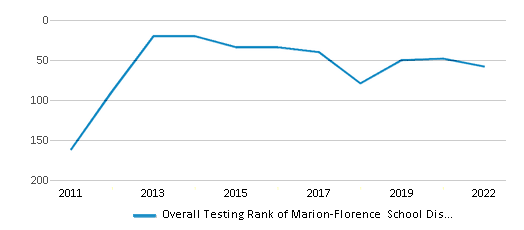
Math Test Scores (% Proficient)
35%
29%
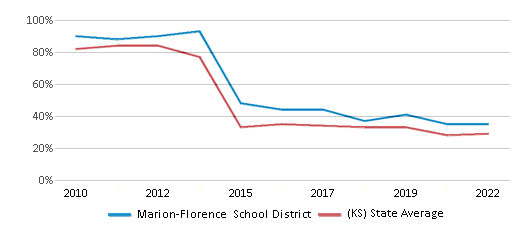
Reading/Language Arts Test Scores (% Proficient)
39%
32%
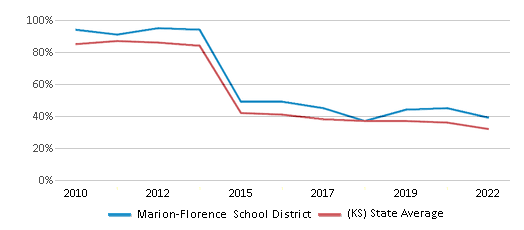
Science Test Scores (% Proficient)
35-39%
31%

Graduation Rate
≥90%
89%
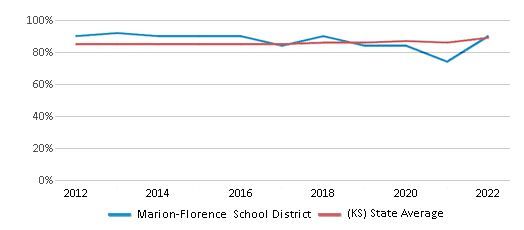
Students by Ethnicity:
Diversity Score
0.24
0.57
# American Indian Students
4 Students
3,553 Students
% American Indian Students
1%
1%
# Asian Students
n/a
13,530 Students
% Asian Students
n/a
3%
# Hispanic Students
45 Students
104,522 Students
% Hispanic Students
8%
22%
# Black Students
6 Students
31,245 Students
% Black Students
1%
7%
# White Students
460 Students
293,371 Students
% White Students
87%
61%
# Hawaiian Students
n/a
1,139 Students
% Hawaiian Students
n/a
n/a
# Two or more races Students
15 Students
30,267 Students
% of Two or more races Students
3%
6%
Students by Grade:
# Students in PK Grade:
40
21,787
# Students in K Grade:
30
31,674
# Students in 1st Grade:
37
32,919
# Students in 2nd Grade:
29
34,119
# Students in 3rd Grade:
47
33,302
# Students in 4th Grade:
32
34,287
# Students in 5th Grade:
43
34,416
# Students in 6th Grade:
36
35,078
# Students in 7th Grade:
44
35,096
# Students in 8th Grade:
39
36,357
# Students in 9th Grade:
42
37,517
# Students in 10th Grade:
48
37,330
# Students in 11th Grade:
32
36,547
# Students in 12th Grade:
31
34,737
# Ungraded Students:
-
2,461
District Revenue and Spending
The revenue/student of $15,781 in this school district is less than the state median of $16,276. The school district revenue/student has declined by 6% over four school years.
The school district's spending/student of $15,457 is less than the state median of $17,192. The school district spending/student has declined by 6% over four school years.
Total Revenue
$8 MM
$7,774 MM
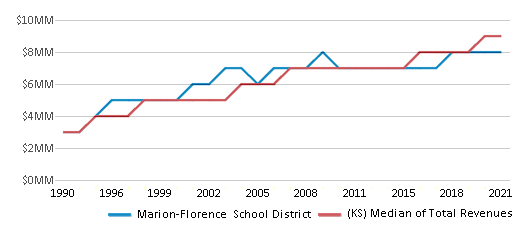
Spending
$8 MM
$8,211 MM
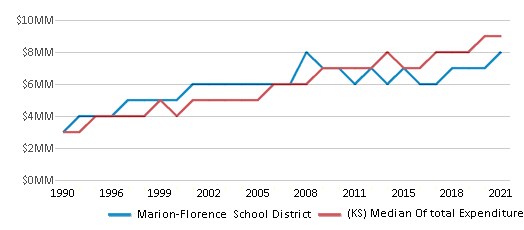
Revenue / Student
$15,781
$16,276
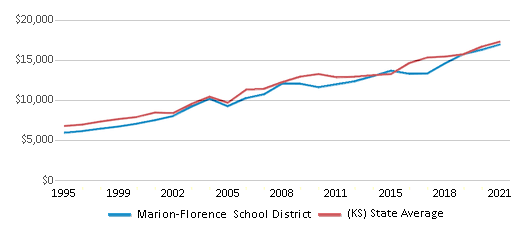
Spending / Student
$15,457
$17,192
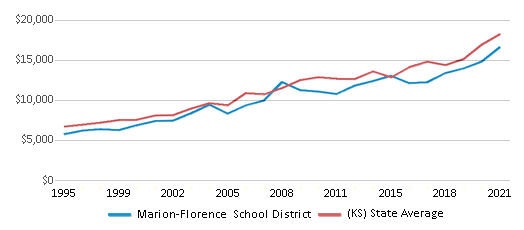
Best Marion-Florence School District Public Schools (2025)
School
(Math and Reading Proficiency)
(Math and Reading Proficiency)
Location
Grades
Students
Rank: #11.
Marion Elementary School
(Math: 40-44% | Reading: 45-49%)
Rank:
Rank:
8/
Top 30%10
1400 E Lawrence
Marion, KS 66861
(620) 382-3771
Marion, KS 66861
(620) 382-3771
Grades: PK-5
| 258 students
Rank: #22.
Marion Middle School
(Math: 25-29% | Reading: 35-39%)
Rank:
Rank:
6/
Top 50%10
125 South Lincoln
Marion, KS 66861
(620) 382-6070
Marion, KS 66861
(620) 382-6070
Grades: 6-8
| 119 students
Rank: #33.
Marion High School
(Math: 21-39% | Reading: ≤20%)
Rank:
Rank:
4/
Bottom 50%10
701 E Main
Marion, KS 66861
(620) 382-2168
Marion, KS 66861
(620) 382-2168
Grades: 9-12
| 153 students
Frequently Asked Questions
How many schools belong to Marion-Florence School District?
Marion-Florence School District manages 3 public schools serving 530 students.
What is the rank of Marion-Florence School District?
Marion-Florence School District is ranked #75 out of 286 school districts in Kansas (top 30%) based off of combined math and reading proficiency testing data for the 2021-2022 school year. This district ranks in the top 20% of Kansas school districts for: Highest reading/language arts proficiency (Top 20%)
What is the racial composition of students in Marion-Florence School District?
87% of Marion-Florence School District students are White, 8% of students are Hispanic, 3% of students are Two or more races, 1% of students are American Indian, and 1% of students are Black.
What is the student/teacher ratio of Marion-Florence School District?
Marion-Florence School District has a student/teacher ratio of 13:1, which is lower than the Kansas state average of 14:1.
What is Marion-Florence School District's spending/student ratio?
The school district's spending/student of $15,457 is less than the state median of $17,192. The school district spending/student has declined by 6% over four school years.
Recent Articles

Year-Round Or Traditional Schedule?
Which is more appropriate for your child? A year-round attendance schedule or traditional schedule? We look at the pros and cons.

Why You Should Encourage Your Child to Join a Sports Team
Participating in team sports has a great many benefits for children, there is no doubt. In this article you will learn what those benefits are.

White Students are Now the Minority in U.S. Public Schools
Increasing birth rates among immigrant families from Asia and Central and South America, combined with lower birth rates among white families, means that for the first time in history, public school students in the United States are majority-minority. This shift in demographics poses difficulties for schools as they work to accommodate children of varying language abilities and socio-economic backgrounds.





